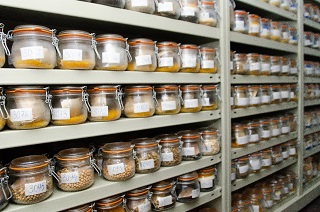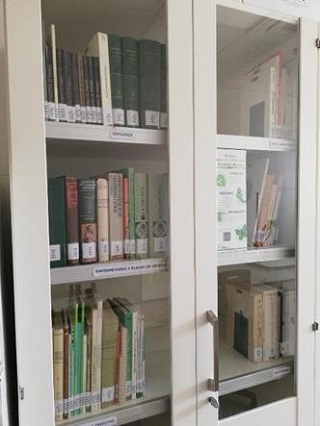
Insectaries
As unique resources, there are specific insectaries for the breeding and maintenance in stable colonies and in laboratory conditions of various species of insects, which act as

vectors for the transmission of diseases especially relevant in the field of animal and human health.
At present, there are colonies of Aedes albopictus (tiger mosquito, an invasive species that can act as a vector transmitting arbovirus diseases such as dengue and chikungunya), Anopheles atroparvus (vector transmitting malaria), Phlebotomus perniciosus and Phlebotomus papatasi (vectors transmitting Leishmaniasis).
These colonies are housed in climatic chambers with controlled temperature, humidity and photoperiod to reproduce the environmental conditions that allow their survival, and are fed by means of artificial feeding systems through membranes. All the facilities have strict biological safety measures to prevent any escape.
The establishment and maintenance of these colonies is subject to various projects for testing control and control methods. Depending on the research activity developed, temporary colonies of Culex pipiens (common mosquito), Musca domestica, Stomoxys calcitrans (stable fly) and fleas have been established and maintained.
More information: Javier Lucientes Curdi (jlucien@unizar.es)
Entomofauna sample bank
The Plant Health Unit has a collection of insect samples as a reference in the study of entomological diversity (intra- and interspecific) of agricultural ecosystems. It serves as a comparative support in the identification of both the auxiliary fauna of crops (olive and almond trees) and of insects that can potentially behave as pests.
More information: Mª Milagro Coca Abia (mcoca@aragon.es)
Genetic resource banks
In order to preserve the genetic diversity of autochthonous varieties and ecotypes of crops and plant and animal species, there are facilities equipped to house and conserve genetic resource banks. Different botanical and entomological collections are also maintained.
Germplasm Bank of Horticultural Species
 Since 1981, it has been responsible for the conservation and management of genetic resources of native varieties of horticultural species, with the aim of preserving biodiversity and promoting their use, research and, in some cases, the recovery of their cultivation.
Since 1981, it has been responsible for the conservation and management of genetic resources of native varieties of horticultural species, with the aim of preserving biodiversity and promoting their use, research and, in some cases, the recovery of their cultivation.
Located in the Aragón Agri-Food Research and Technology Center, it currently has approximately 17,000 seed samples belonging to more than 300 species, highlighting important specific collections such as tomato, bell pepper, melon, cucumber, lettuce, onion, bean, brassica and parsley. For their conservation, the necessary greenhouses and plots are available for sowing and replanting to obtain the seeds, as well as the equipment for their subsequent conditioning and drying, and freezing chambers for their storage at -18ºC.
This germplasm bank is part of the Collections Network of the National Program of Phytogenetic Resources, which participates in the permanent actions of the National Program for the Conservation and Sustainable Use of Plant Genetic Resources for Agriculture and Food, managed by the National Institute for Agricultural and Food Research and Technology (INIA).
Contact: Cristina Mallor (cmallor@aragon.es)
More information: Banco de Germoplasma de Especies Hortícolas de Zaragoza.
Fruit Species Phytogenetic Resources Bank
It houses collections of several varieties of apricot, almond, cherry, plum, wild species of Prunus, apple, peach, pear and stone and pip rootstocks, as well as a collection of mountain germplasm, which includes stone and pip fruit trees and other traditional species such as acerola, galimbasta, pomegranate and quince. Certain varieties of almond, plum and peach trees are also references of the Spanish Plant Variety Office (OEVV, MAPA) and of the European Office for the description and identification of new varieties submitted for registration (CPVO).
For more than 50 years, these collections have been maintained "in vivo" with the aim of preserving the specimens in the best possible conditions, for their maintenance and use in research and genetic improvement programs, or for their recovery in the diversification of agricultural production.
The material is mainly found in experimental agricultural and livestock farms located in the province of Zaragoza and Huesca and specifically one of them, La Garcipollera, specialized in prospecting, characterization and conservation of native fruit germplasm of mountain areas.
Contact: Pilar Errea Abad (perrea@aragon.es)
“In vivo” animal germplasm bank: experimental livestock herds
In the experimental farm "La Garcipollera", located in a Pyrenean high mountain enclave, there are several experimental herds for in situ conservation and maintenance of the Parda de Montaña and Pirenaica cattle breeds (both recognized as Autochthonous Breeds of Promotion in the Official Catalog of Spanish Cattle Breeds), and of the Churra Tensina sheep breed (Autochthonous Breed in Danger of Extinction). The zootechnical characterization, conservation and improvement of these breeds is carried out with the aim of maintaining animals with their defined racial patterns, and with this, the conservation of native livestock genetic material and the promotion of genetic diversity by disseminating improving animals.
The studies and controls of the breeds are carried out jointly with the livestock associations officially recognized for each of the breeds, and are included in the databases of genetic valuation of the animals.
In turn, these animals are the basis for research projects that allow the study of systems, feeding, reproductive management and finally the quality of the animal product of autochthonous livestock in conventional and organic production.
Contact: Mireia Blanco Alibes (mblanco@aragon.es)
Botanical garden of arvenous species of CITA.
In the Aula Dei Campus, within the facilities of the Center for Agri-Food Research and Technology of Aragon, is located this living collection with more than 260 different species, the vast majority considered as weeds (arvense flora), although it also houses other rare species and certain minor crops.
The plants, grown in pots, are separated into two large groups:
- Autumn - winter germinating species.
- Spring-summer germinating species. These have an individualized irrigation system.
The uniqueness of this garden lies in the fact that, in addition to the common species that interfere with the crops, it houses certain peculiar plants that can only be found in  a few locations in Aragon, since they are species that have not adapted to a system of intensive cereal cultivation, and only survive in fields of extensive management in some high areas of the provinces of Teruel and Huesca. In addition, for informative and preventive purposes, it also houses other invasive plants not yet widespread in Aragon, adopting all the necessary measures to prevent their expansion.
a few locations in Aragon, since they are species that have not adapted to a system of intensive cereal cultivation, and only survive in fields of extensive management in some high areas of the provinces of Teruel and Huesca. In addition, for informative and preventive purposes, it also houses other invasive plants not yet widespread in Aragon, adopting all the necessary measures to prevent their expansion.
The purpose of this collection is to have seedlings and adult plants available for study and for the creation of an image bank to facilitate the identification of other specimens, and to serve for specialized publications on the subject. Studies of their phenological behavior are also carried out.
In addition, there is a seed bank of weed species from the collection of plants grown in this garden.
This collection provides important support for educational activities in which the center collaborates, aimed at students of specialized training in the sector (agricultural and forestry vocational training, gardening, agricultural engineering) or other groups related to the sector.
Contact: Alicia Cirujeda Razenberger (acirujeda@aragon.es)
More information: Jardín botánico de especies arvenses del CITA
Bibliographic Fund of Plant Health
The Plant Health Laboratory of the Escuela Politécnica Superior de Huesca houses an important catalogued bibliographic collection, donated by the Centro de Sanidad y Certificación Vegetal of the Government of Aragón, and integrated in the catalog of the Library of the University of Zaragoza. It contains copies of agriculture, zoology, entomology, forest pathology, crop diseases and pests, and pesticides. Among others, it is worth mentioning the treatise Entomologie appliquée a l'agriculture / traité publié sous la direction de A.S. Balachowsky. Paris : Masson et Cie, 1962-1972, the collection Animal enemies of cultivated and forest plants / L. Bonnemaison. Vilassar de Mar : Oikos-tau, 1975-1976, and Atlas des diptères de France, Belgique, Suisse / E. Séguy. Paris : N. Boubbée, 1951.
Responsible: Joaquín Aibar Lete (jaibar@unizar.es)

